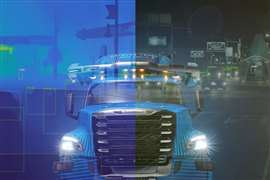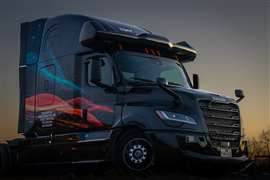The story behind autonomous driving at Daimler Truck
04 July 2025
The Level 4 system from Torc Robotics is ready for the road. Julian Buckley takes a look at development of the self-driving technology
 Autonomous system uses cameras, RADAR and LiDAR to understand surrounding environment (All photos courtesy of Daimler Truck)
Autonomous system uses cameras, RADAR and LiDAR to understand surrounding environment (All photos courtesy of Daimler Truck)
It was back in 2020 that Daimler Truck and autonomous driving technology company Waymo announced that they had entered into a strategic partnership for development and deployment of a system that would support Level 4 self-driving in heavy-duty vehicles based on the Waymo Driver platform.
Just a few years later in 2023, Waymo revealed that it was to ‘push back the timeline’ on its efforts to produce an autonomous driving system for commercial trucks. The decision followed slower-than-expected regulatory approval for trucks using autonomous systems on public roads, combined with the tempting revenue potential of an autonomous driving system for the ride-hailing (taxi) market.
Keeping all that in mind, in 2019 Daimler Truck acquired Torc Robotics. The independent subsidiary went on to be tasked with development of its own Level 4 self-driving system for heavy-duty vehicles.
It sounds like the same story with a different name. But where Waymo has effectively put its Level 4 autonomous driving system for trucks on ice, Torc has continued with development of its own Virtual Driver system – a system which incorporates hub-to-hub capability, the holy grail of commercial vehicle driving autonomy.
Dual tracking
Daimler Truck has outlined a series of reasons for adopting a two-company strategy for development of its autonomous driving capability. While reducing the cost burden on any single company, each development team could work within its specialist area. At the same time, the strategy would mitigate against one or the other failing to deliver a working system.
 System redundancy map on Freightliner Cascadia
System redundancy map on Freightliner Cascadia
There is also a substantial level of redundancy across autonomous driving systems. With both Waymo and Torc basing systems on the Freightliner Cascadia HD truck, the companies could share changes to chassis systems and other components needed to support functionality and safety.
Yet while Waymo has stepped back from development of an autonomous system for trucks (there are still reported to be future plans to resume commercialisation of its system), it is Torc which has moved forward with its a Level 4 system for Daimler Truck.
Since 2022, the subsidiary has been working with US logistics companies to help gather information to help with applying these systems to operational trucks. As part of this, the company has established the Torc Autonomous Advisory Council to better integrate industry expertise into the development process.
Companies including Schneider, Covenant Logistics, Penske Truck Leasing, Ryder Systems, CH Robinson and Baton, together with Daimler Truck North America, have advised on how to best integrate autonomous systems into existing business models – including ‘operative’ topics which go beyond highway driving.
Supported by this collaborative approach, Torc has now combined various features to help take the system to the next development phase; there are plans are to bring a Level 4 autonomous truck driving system which supports hub-to-hub operation across in the United States in 2027.
Current capability
In April 2025, Daimler Truck North America reported that it had started deliveries of the latest fifth-generation Freightliner Cascadia for testing in the autonomous fleet at Torc Robotics. The trucks have a series of new features, including improved aerodynamics, telematics and safety systems. The new X15N Natural Gas engine from Cummins is available as an option.
At the launch of the new model, Joanna Buttler, head of the Autonomous Technology Group at Daimler Truck, said: “Delivering the latest iteration of our autonomous-ready vehicle platform, including production-intent autonomy hardware to Torc, marks a significant milestone for Daimler Truck towards series maturity and scaling.”
To support Level 4 autonomy the new flagship model has more than 1,500 engineering changes to create the necessary system redundancy across a series of safety-critical areas. These include such primary functions as steering and braking, together with a secondary set of electronically-controlled systems to act as an integrated backup power network.
Driving the autonomous functionality is a combination of sensing hardware including cameras, RADAR and LiDAR which combine to deliver a complete picture of traffic and road hazards.
Those vehicles set to have the autonomous driving system installed have all related computing and sensor kits installed during vehicle assembly in preparation for addition of the Virtual Driver system.
Testing routes
In addition to test routes in New Mexico, Texas and Arizona, the trucks will also operate in autonomous mode on a new lane added to I-35 in Texas between Laredo and Dallas.
 Freightliner Cascadia on autonomous test route in Texas
Freightliner Cascadia on autonomous test route in Texas
As part of this, Torc has signed a leasing agreement for what will serve as a hub designed specifically for autonomous vehicles in the Dallas-Fort Worth area. This will become the base of Torc’s autonomous testing and customer freight pilots as the company plans future commercialisation.
As of 2024, Torc had successfully completed driver-out test runs on a multi-lane test track in Texas. Next, Daimler Truck and Torc will look to repeat this driverless test on a public road (all self-driving tests to date on public roads have been operated with a driver onboard).
Peter Vaughan Schmidt, CEO of Torc, said: “Our strong collaboration with Daimler Truck represents six years of success in advancing the future of freight. Fully integrating Torc’s autonomous driver with Daimler Truck’s Freightliner Cascadia platform creates an industry-first, scalable, physical-AI autonomous trucking solution. This will unlock tremendous value for our customers by addressing key industry pain points and presents a clear opportunity to generate revenue and drive meaningful transformation across the industry.”
Myth and truth
According to Daimler Truck, autonomous trucks can ‘enhance business operations and manage increasing freight volumes’. To support this, the OEM has released a series of statements in response to what it describes as ‘myths’ about autonomous trucks.
 New fifth-generation Freightliner Cascadia with autonomous driving hardware
New fifth-generation Freightliner Cascadia with autonomous driving hardware
The first of these is that the advent of autonomous heavy-duty trucks could mean the beginning of the end for human truck drivers. Daimler Truck puts forward that the self-driving truck model would ‘potentially create new job profiles’ and opportunities beyond the task of driving.
For example, the autonomous fleet will need human support at first and last mile, while people will be needed to monitor trucks. For this, operations managers will be critical to successful execution.
Self-driving trucks will also help address driver shortages. According to the American Trucking Associations, freight tonnage in the US is expected to increase from 16 billion (2019) to 21 billion tons by 2030. Self-driving trucks will support this increase in volume, while addressing the ever-changing number of professional truck drivers.
There’s even a case for self-driving trucks to have less environmental impact. This is because the trucks could operate when there is less traffic and so move at a more constant speed that produces less emissions.
Whether you love or hate the idea of autonomous trucks operating on a highway near you, it would appear that the technology is on the way. It’s impossible to say how these plans will play out, but one thing is sure – flawless, accident-free execution of the initial rollout will be critical to wider adoption and future success.
POWER SOURCING GUIDE
The trusted reference and buyer’s guide for 83 years
The original “desktop search engine,” guiding nearly 10,000 users in more than 90 countries it is the primary reference for specifications and details on all the components that go into engine systems.
Visit Now
STAY CONNECTED




Receive the information you need when you need it through our world-leading magazines, newsletters and daily briefings.
CONNECT WITH THE TEAM










